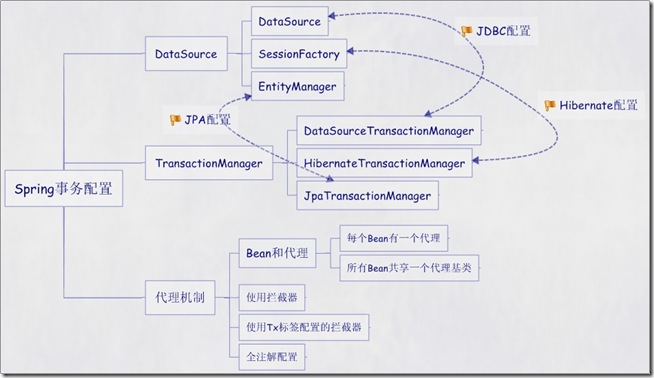(转)Spring事务配置的五种方式
前段时间对Spring的事务配置做了比较深入的研究,在此之间对Spring的事务配置虽说也配置过,但是一直没有一个清楚的认识。通过这次的学习发觉Spring的事务配置只要把思路理清,还是比较好掌握的。
总结如下:
Spring配置文件中关于事务配置总是由三个组成部分,分别是DataSource、TransactionManager和代理机制这三部分,无论哪种配置方式,一般变化的只是代理机制这部分。
DataSource、TransactionManager这两部分只是会根据数据访问方式有所变化,比如使用Hibernate进行数据访问时,DataSource实际为SessionFactory,TransactionManager的实现为HibernateTransactionManager。
具体如下图:

根据代理机制的不同,总结了五种Spring事务的配置方式,配置文件如下:
第一种方式:每个Bean都有一个代理
<beans xmlns="http://www.springframework.org/schema/beans"
xmlns:xsi="http://www.w3.org/2001/XMLSchema-instance"
xmlns:context="http://www.springframework.org/schema/context"
xmlns:aop="http://www.springframework.org/schema/aop"
xsi:schemaLocation="http://www.springframework.org/schema/beans
http://www.springframework.org/schema/beans/spring-beans-2.5.xsd
http://www.springframework.org/schema/context
http://www.springframework.org/schema/context/spring-context-2.5.xsd
http://www.springframework.org/schema/aop http://www.springframework.org/schema/aop/spring-aop-2.5.xsd">
<bean
id="sessionFactory"
class="org.springframework.orm.hibernate3.LocalSessionFactoryBean">
<property
name="configLocation" value="classpath:hibernate.cfg.xml" />
<property
name="configurationClass" value="org.hibernate.cfg.AnnotationConfiguration" />
</bean>
<!-- 定义事务管理器(声明式的事务)
-->
<bean
id="transactionManager"
class="org.springframework.orm.hibernate3.HibernateTransactionManager">
<property
name="sessionFactory" ref="sessionFactory" />
</bean>
<!-- 配置DAO
-->
<bean
id="userDaoTarget" class="com.bluesky.spring.dao.UserDaoImpl">
<property
name="sessionFactory" ref="sessionFactory" />
</bean>
<bean
id="userDao"
class="org.springframework.transaction.interceptor.TransactionProxyFactoryBean">
<!-- 配置事务管理器
-->
<property
name="transactionManager" ref="transactionManager" />
<property
name="target" ref="userDaoTarget" />
<property
name="proxyInterfaces" value="com.bluesky.spring.dao.GeneratorDao" />
<!-- 配置事务属性
-->
<property
name="transactionAttributes">
<props>
<prop
key="*">PROPAGATION_REQUIRED</prop>
</props>
</property>
</bean>
</beans>
第二种方式:所有Bean共享一个代理基类
<beans xmlns="http://www.springframework.org/schema/beans"
xmlns:xsi="http://www.w3.org/2001/XMLSchema-instance"
xmlns:context="http://www.springframework.org/schema/context"
xmlns:aop="http://www.springframework.org/schema/aop"
xsi:schemaLocation="http://www.springframework.org/schema/beans
http://www.springframework.org/schema/beans/spring-beans-2.5.xsd
http://www.springframework.org/schema/context
http://www.springframework.org/schema/context/spring-context-2.5.xsd
http://www.springframework.org/schema/aop http://www.springframework.org/schema/aop/spring-aop-2.5.xsd">
<bean
id="sessionFactory"
class="org.springframework.orm.hibernate3.LocalSessionFactoryBean">
<property
name="configLocation" value="classpath:hibernate.cfg.xml" />
<property
name="configurationClass" value="org.hibernate.cfg.AnnotationConfiguration" />
</bean>
<!-- 定义事务管理器(声明式的事务)
-->
<bean
id="transactionManager"
class="org.springframework.orm.hibernate3.HibernateTransactionManager">
<property
name="sessionFactory" ref="sessionFactory" />
</bean>
<bean
id="transactionBase"
class="org.springframework.transaction.interceptor.TransactionProxyFactoryBean"
lazy-init="true" abstract="true">
<!-- 配置事务管理器
-->
<property
name="transactionManager" ref="transactionManager" />
<!-- 配置事务属性
-->
<property
name="transactionAttributes">
<props>
<prop
key="*">PROPAGATION_REQUIRED</prop>
</props>
</property>
</bean>
<!-- 配置DAO
-->
<bean
id="userDaoTarget" class="com.bluesky.spring.dao.UserDaoImpl">
<property
name="sessionFactory" ref="sessionFactory" />
</bean>
<bean
id="userDao" parent="transactionBase" >
<property
name="target" ref="userDaoTarget" />
</bean>
</beans>
第三种方式:使用拦截器
<beans xmlns="http://www.springframework.org/schema/beans"
xmlns:xsi="http://www.w3.org/2001/XMLSchema-instance"
xmlns:context="http://www.springframework.org/schema/context"
xmlns:aop="http://www.springframework.org/schema/aop"
xsi:schemaLocation="http://www.springframework.org/schema/beans
http://www.springframework.org/schema/beans/spring-beans-2.5.xsd
http://www.springframework.org/schema/context
http://www.springframework.org/schema/context/spring-context-2.5.xsd
http://www.springframework.org/schema/aop http://www.springframework.org/schema/aop/spring-aop-2.5.xsd">
<bean
id="sessionFactory"
class="org.springframework.orm.hibernate3.LocalSessionFactoryBean">
<property
name="configLocation" value="classpath:hibernate.cfg.xml" />
<property
name="configurationClass" value="org.hibernate.cfg.AnnotationConfiguration" />
</bean>
<!-- 定义事务管理器(声明式的事务)
-->
<bean
id="transactionManager"
class="org.springframework.orm.hibernate3.HibernateTransactionManager">
<property
name="sessionFactory" ref="sessionFactory" />
</bean>
<bean
id="transactionInterceptor"
class="org.springframework.transaction.interceptor.TransactionInterceptor">
<property
name="transactionManager" ref="transactionManager" />
<!-- 配置事务属性
-->
<property
name="transactionAttributes">
<props>
<prop
key="*">PROPAGATION_REQUIRED</prop>
</props>
</property>
</bean>
<bean
class="org.springframework.aop.framework.autoproxy.BeanNameAutoProxyCreator">
<property
name="beanNames">
<list>
<value>*Dao</value>
</list>
</property>
<property
name="interceptorNames">
<list>
<value>transactionInterceptor</value>
</list>
</property>
</bean>
<!-- 配置DAO
-->
<bean
id="userDao" class="com.bluesky.spring.dao.UserDaoImpl">
<property
name="sessionFactory" ref="sessionFactory" />
</bean>
</beans>
第四种方式:使用tx标签配置的拦截器
<beans xmlns="http://www.springframework.org/schema/beans"
xmlns:xsi="http://www.w3.org/2001/XMLSchema-instance"
xmlns:context="http://www.springframework.org/schema/context"
xmlns:aop="http://www.springframework.org/schema/aop"
xmlns:tx="http://www.springframework.org/schema/tx"
xsi:schemaLocation="http://www.springframework.org/schema/beans
http://www.springframework.org/schema/beans/spring-beans-2.5.xsd
http://www.springframework.org/schema/context
http://www.springframework.org/schema/context/spring-context-2.5.xsd
http://www.springframework.org/schema/aop http://www.springframework.org/schema/aop/spring-aop-2.5.xsd
http://www.springframework.org/schema/tx http://www.springframework.org/schema/tx/spring-tx-2.5.xsd">
<context:annotation-config
/>
<context:component-scan
base-package="com.bluesky" />
<bean
id="sessionFactory"
class="org.springframework.orm.hibernate3.LocalSessionFactoryBean">
<property
name="configLocation" value="classpath:hibernate.cfg.xml" />
<property
name="configurationClass" value="org.hibernate.cfg.AnnotationConfiguration" />
</bean>
<!-- 定义事务管理器(声明式的事务)
-->
<bean
id="transactionManager"
class="org.springframework.orm.hibernate3.HibernateTransactionManager">
<property
name="sessionFactory" ref="sessionFactory" />
</bean>
<tx:advice
id="txAdvice" transaction-manager="transactionManager">
<tx:attributes>
<tx:method
name="*" propagation="REQUIRED" />
</tx:attributes>
</tx:advice>
<aop:config>
<aop:pointcut
id="interceptorPointCuts"
expression="execution(* com.bluesky.spring.dao.*.*(..))" />
<aop:advisor
advice-ref="txAdvice"
pointcut-ref="interceptorPointCuts" />
</aop:config>
</beans>
第五种方式:全注解
<beans xmlns="http://www.springframework.org/schema/beans"
xmlns:xsi="http://www.w3.org/2001/XMLSchema-instance"
xmlns:context="http://www.springframework.org/schema/context"
xmlns:aop="http://www.springframework.org/schema/aop"
xmlns:tx="http://www.springframework.org/schema/tx"
xsi:schemaLocation="http://www.springframework.org/schema/beans
http://www.springframework.org/schema/beans/spring-beans-2.5.xsd
http://www.springframework.org/schema/context
http://www.springframework.org/schema/context/spring-context-2.5.xsd
http://www.springframework.org/schema/aop http://www.springframework.org/schema/aop/spring-aop-2.5.xsd
http://www.springframework.org/schema/tx http://www.springframework.org/schema/tx/spring-tx-2.5.xsd">
<context:annotation-config
/>
<context:component-scan
base-package="com.bluesky" />
<tx:annotation-driven
transaction-manager="transactionManager"/>
<bean
id="sessionFactory"
class="org.springframework.orm.hibernate3.LocalSessionFactoryBean">
<property
name="configLocation" value="classpath:hibernate.cfg.xml" />
<property
name="configurationClass" value="org.hibernate.cfg.AnnotationConfiguration" />
</bean>
<!-- 定义事务管理器(声明式的事务)
-->
<bean
id="transactionManager"
class="org.springframework.orm.hibernate3.HibernateTransactionManager">
<property
name="sessionFactory" ref="sessionFactory" />
</bean>
</beans>
此时在DAO上需加上@Transactional注解,如下:
import java.util.List;
import org.hibernate.SessionFactory;
import org.springframework.beans.factory.annotation.Autowired;
import org.springframework.orm.hibernate3.support.HibernateDaoSupport;
import org.springframework.stereotype.Component;
import com.bluesky.spring.domain.User;
@Transactional
@Component("userDao")
public class UserDaoImpl
extends HibernateDaoSupport
implements UserDao {
public List<User> listUsers() {
return this.getSession().createQuery("from
User").list();
}

}
(转)Spring事务配置的五种方式的更多相关文章
- Spring事务配置的五种方式(转发)
Spring事务配置的五种方式(原博客地址是http://www.blogjava.net/robbie/archive/2009/04/05/264003.html)挺好的,收藏转发 前段时间对Sp ...
- Spring事务配置的五种方式和spring里面事务的传播属性和事务隔离级别
转: http://blog.csdn.net/it_man/article/details/5074371 Spring事务配置的五种方式 前段时间对Spring的事务配置做了比较深入的研究,在此之 ...
- Spring事务配置的五种方式(转载)
Spring配置文件中关于事务配置总是由三个组成部分,分别是DataSource.TransactionManager和代理机制这三部分,无论哪种配置方式,一般变化的只是代理机制这部分. DataSo ...
- Spring事务配置的五种方式
Spring配置文件中关于事务配置总是由三个组成部分,分别是DataSource.TransactionManager和代理机制这三部分,无论哪种配置方式,一般变化的只是代理机制这部分. DataSo ...
- Spring事务配置的五种方式 -- 越往后需要Spring版本越高
第五种 基本零配置 个人感觉第四种也可以 Spring配置文件中关于事务配置总是由三个组成部分,分别是DataSource.TransactionManager和代理机制这三部分,无论哪种配置方式, ...
- Spring事务配置的五种方式(转)
前段时间对Spring的事务配置做了比较深入的研究,在此之间对Spring的事务配置虽说也配置过,但是一直没有一个清楚的认识.通过这次的学习发觉Spring的事务配置只要把思路理清,还是比较好掌握的. ...
- Spring事务配置的五种方式 巨全!不看后悔,一看必懂!
前段时间对Spring的事务配置做了比较深入的研究,在此之间对Spring的事务配置虽说也配置过,但是一直没有一个清楚的认识.通过这次的学习发觉Spring的事务配置只要把思路理清,还是比较好掌握的. ...
- SSH深度历险(六) 深入浅出----- Spring事务配置的五种方式
这对时间在学习SSH中Spring架构,Spring的事务配置做了详细总结,在此之间对Spring的事务配置只是停留在听说的阶段,总结一下,整体把控,通过这次的学习发觉Spring的事务配置只要把思路 ...
- [JavaEE] Spring事务配置的五种方式
前段时间对Spring的事务配置做了比较深入的研究,在此之间对Spring的事务配置虽说也配置过,但是一直没有一个清楚的认识.通过这次的学习发觉Spring的事务配置只要把思路理清,还是比较好掌握的. ...
随机推荐
- css清除浮动的集中方法
一:浮动产生的副作用 1.父元素的背景不能显示 2.父元素的边框不能撑开 3.padding和margin失效 二:清除浮动的方法 1.给父元素设置高度:这样可以清除浮动,但是子元素内容高度不固定,这 ...
- 单人纸牌_NOI导刊2011提高(04)
单人纸牌 时间限制: 1 Sec 内存限制: 128 MB 题目描述 单人纸牌游戏,共 36 张牌分成 9 叠,每叠 4 张牌面向上.每次,游戏者可以从某两个不同的牌堆最顶上取出两张牌面相同的牌(如 ...
- [Apio2012]dispatching
[Apio2012]dispatching 时间限制: 1 Sec 内存限制: 128 MB 题目描述 在一个忍者的帮派里,一些忍者们被选中派遣给顾客,然后依据自己的工作获取报偿.在这个帮派里,有一 ...
- CoolBlog开发笔记第4课:数据库模型设计
教程目录 1.1 CoolBlog开发笔记第1课:项目分析 1.2 CoolBlog开发笔记第2课:搭建开发环境 1.3 CoolBlog开发笔记第3课:创建Django应用 前言 我新书<Py ...
- chrome谷歌浏览器-DevTool开发者工具-详细总结
目录: 一.概述 1.官方文档 2.打开方法: 3.前言: 二.九个模块: 1.设备模式Device Mode 2.元素面板Elements 3.控制台面板Console 4.源代码面板Sources ...
- 将Win7系统将默认打开的库改为计算机
- Redux-Saga学习心得
# Redux Saga ## 简述- Reducers负责处理action的state更新:- Sagas负责协调那些复杂或异步的操作. ## 安装 npm install --save redux ...
- 用php+mysql+ajax实现淘宝客服或阿里旺旺聊天功能 之 后台页面
在上一篇随笔中,我们已经看了如何实现前台的对话功能:前台我限定了店主只有一人,店铺只有一个,所有比较单一,但后台就不一样了,而后台更像是我们常见的聊天软件:当然,前台也应该实现这种效果,但原理懂了,可 ...
- AngularJs学习笔记1——总体介绍
这周末在家呆了两天,正好中午闲暇时间继续分享Angularjs相关,今天主要分享Angularjs总体介绍及数据绑定部分内容,下面直接进入主题. 1.基本概念: AngularJS是为了克服HTML在 ...
- orcle 索引的使用
2.4.3.1. 索引的概念 数据库中的索引与书籍中的索引类似,在一本书中,利用索引可以快速查找所需信息, 无须阅读整本书.在数据库中,索引使数据库程序无须对整个表进行扫描, 就可以在其中找到所需数据 ...
